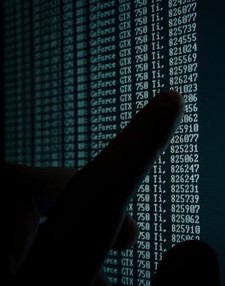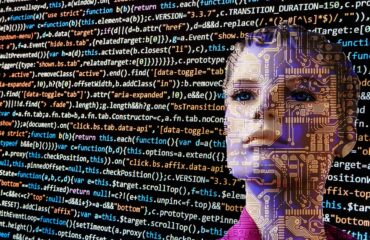
Image by Pete Linforth
By James Myers
This article is part of The Quantum Record’s ongoing series on Quantum Ethics, with six issues introduced in our May 2024 feature Quantum Ethics: There’s No Time Like the Present to Plan for the Human Future With Quantum Technology.
While technological challenges continue to limit its practical applications, quantum computing is a major focus of research and investment by companies and central banks for its potential uses in finance and financial markets. Although the power of the quantum computer could reduce the uncertainties in single financial trades, increased attention is being paid to the large-scale market risks of the technology’s predictive potential.
Concern about the effects of AI in financial markets is already so significant that in a speech last December to the U.S. Financial Stability Oversight Council, the Chair of the Securities and Exchange Commission (SEC), Gary Gensler, warned, “AI may heighten financial fragility, as it could promote herding among individual actors making similar decisions as they get the same signal from a base model or data aggregator. This could encourage monocultures. It also could exacerbate the inherent network interconnectedness of the global financial system.”
In FINRA’s annual report published in January (pdf available), the self-regulatory organization that oversees brokers and dealers that trade on U.S. markets labelled AI an “emerging risk” in financial markets. The report notes that, “As in other industries, broker-dealers and other financial services industry firms are exploring and deploying these technologies—either with in-house solutions or through third parties—to create operational efficiencies and better serve their customers. While these tools may present promising opportunities, their development has been marked by concerns about accuracy, privacy, bias and intellectual property, among others.”
With mounting concerns about AI in financial markets, what effects will quantum computing have on trading and market values?
Major market traders such as Goldman Sachs are investing heavily in efforts to amplify, with quantum computing, the already powerful role of AI in finance. Quantum computers could be particularly effective in estimating future values of assets traded on U.S. markets that are regulated by the SEC and on other exchanges around the globe.
Finance involves complex calculations for tasks such as estimating future trading values and risks for financial derivatives, a major class of assets that includes stock options, forward contracts and interest rate swaps. The calculations involve many mathematical problems in combinations and permutations that challenge today’s most powerful computers but could be particularly well-suited to the quantum computer’s speed and greater computational capacity.

The graph on the left illustrates that quantum algorithms will compute larger problem sets more quickly than today’s computers. The graph on the right illustrates the potential for quantum computers to approach far more closely a theoretically optimal future value calculation than today’s binary computers can. Image from Bank for International Settlements October 2024 paper, Quantum computing and the financial system: opportunities and risks (PDF available).
Trading in derivatives, which are contracts for the exchange of assets between two or more parties at specified future dates, is based on the present and expected future values of the contract’s underlying asset – which could be, for example, company shares, interest-bearing debts, and commodities such as oil, wheat, and gold.
Since there are many differing estimates and opinions of future prices, calculations of future values that rely heavily on current trends can differ significantly from actual values when the contracts are finally settled at a later date.
Derivatives markets, therefore entail significant risks not only to traders but, given their magnitude and risks, to the global economic structure.
While the enhanced calculation power of quantum computers could reduce estimation risk, the machine’s superior speed and accuracy involving many variables could also provide a major market advantage to traders with access to the technology at the expense of those who haven’t yet developed the capability.
The speed and versatility of quantum calculations could also magnify instabilities in the market. For example, if the probable future values produced in a quantum calculation are based on incomplete information or are exposed to the sudden eruption of unpredictable events like wars, environmental catastrophes, and geopolitical shocks, the technology could contribute to greater uncertainty and risk in future values.
How much is at risk? The precise measure of derivatives values traded daily isn’t available because not all contracts are traded on public markets, however, the known and estimated amounts are staggering.
The Bank for International Settlements, which was created in 1930 and is owned by 63 national banks that regulate the vast majority of the world’s money supply, pegged the derivatives market value as of June 2023 at nearly three-quarters of a quadrillion dollars. A quadrillion is 1 followed by fifteen 0’s. For comparison, the annual gross domestic product (GDP) in 2023 of the world’s wealthiest nation, the U.S., was 27.94 trillion dollars (a trillion is one thousand times less than quadrillion, in other words, 1 followed by twelve 0’s), and the national debt of the U.S. is currently approaching 36 trillion dollars.

The massive estimated value of derivatives contracts traded in public and private markets, categorized by underlying asset type, is shown in this graph from the Bank for International Settlements. In two years, the value traded increased by 17%. The rapid growth in interest rate derivatives is attributed to the sharp increase in interest rates for major currencies triggered by the Covid pandemic. Chart from the International Swaps and Derivative Association (ISDA) report “Key Trends in the Size and Composition of OTC Derivatives Markets in the First Half of 2003” (PDF available).
Trading in derivatives far outpaces measures of economic output like GDP and government promises to repay past debts, and as a result of their impressive size, the values placed on derivatives can trigger sudden financial crises. The crisis of 2008, with consequences lasting well into the decade that ended only four years ago, serves as a warning of the need for controls to avoid calculations of excessive value and unrealistic expectations that could be amplified with the capacity of quantum computing.
The global market meltdown of 2008 was fuelled by the rapid increase in unrealistic trading values of derivatives based on subprime mortgage loans to low-income homebuyers. When it became clear that inadequate banking regulations had permitted excessive lending to borrowers who often lacked the resources to pay either interest or principal and that the debts far exceeded the collateral value of the homes, the derivative value of mortgage-backed securities crashed. By September 2008, the market crisis vaporized much of the value of mortgage derivatives, which sparked the largest bankruptcy in U.S. history when subprime lender and derivatives trader Lehman Brothers could no longer obtain credit to meet its obligations.
Years were required for financial markets to regain losses incurred in the 2008 crash when the credit crisis of Lehman Brothers and exceedingly low public confidence in market values quickly spread to threaten the existence of major banks and key industries underpinning entire national economies. To prevent the contagion of lost trust in the markets from spreading, governments around the world were left with no choice but to intervene with financial support for major economic actors. As a result, the U.S. government became, for a time, the controlling shareholder of General Motors, the world’s largest carmaker at that time.
The promise along with the risks of quantum computing in finance are beginning to emerge.
Quantum computing promises a method to calculate probabilities for future values with greater speed and accuracy and with far more variables and factors than conventional computers can manage.

Image from Who’s afraid of the big, bad algorithm? The truth about algorithmic trading, Oxford University, Saïd Business School. The 2019 article presents a generally positive view of the potential for algorithmic trading.
For example, the binary circuits of today’s computers are limited in their capacity to calculate the future value of a stock option which commonly involves what are called Monte Carlo simulations. In a Monte Carlo simulation, many known variables are combined with random factors in computations that are repeated many times to calculate the average probability of a stock option’s value when the contract ends at a later date.
Outpacing today’s most capable computers with a greater number of variables and more iterations over longer timeframes, in theory, a quantum computer’s Monte Carlo simulation could produce a more reliable calculation of expected future value.
While this could reduce the risk of a financial derivative for an investor or issuer, it could also expose the market to the risk of miscalculation. For example, greater calculation risk could emerge from the improper application of variables or the use of factors that can rapidly become obsolete when markets respond to unpredictable human events like wars and other geopolitical or environmental upheavals.
Errors and miscalculations at quantum speed and volume could entail widespread and potentially runaway consequences in globally integrated markets, where most trading is not made by human decision but by algorithms.
Traders are not required to disclose whether their trading decisions are made by computer algorithms or by humans, but survey data indicate that a very significant proportion of trading is already algorithmically determined without human intervention. Some assets traded, particularly cryptocurrencies, are themselves the products of algorithms.
One study showed that by 2019 trading by algorithm comprised nearly all – 92% – of trading in currencies. Most estimates indicate that algorithmic trading now accounts for between 60% and 75% of all trades on the markets, with computers conducting large numbers of buy and sell transactions far more quickly than humans can. The machines execute trades based on programmed thresholds for a myriad of market factors including trading price, volume, and volatility.
Since the majority of individual trades are made by computers programmed to react to trading outcomes, algorithms dominate not only in any given trade but their programmed instructions prevail in long sequences of trades over days, weeks, months, and years. If, for example, 60% of today’s trades are algorithmic, then algorithms will respond tomorrow to the 60% of today’s trading outcomes that were determined by algorithms. Each successive majority of algorithmic outcomes decreases the human influence on trading values over time.
The prevalence of algorithmic trading, combined with increased market risks from the volatile inflationary and high-interest rate environment of the past four years triggered by the Covid pandemic, could warrant careful attention and regulatory enforcement. The 47% increase in interest rate derivatives traded during the period from 2021 to 2023, shown in the following chart, illustrates a greater exposure to sudden changes in market conditions.

The 47% increase in the value of interest rate derivatives traded in the volatile interest rate environment from 2021 to 2023 illustrates increased exposure to changes in market conditions. Image from the International Swaps and Derivatives Association (ISDA) report “Key Trends in the Size and Composition of OTC Derivatives Markets in the First Half of 2023” (PDF available).
While calculations for shorter contract durations reduce the risk that time contributes to the estimation of future values, shorter-term calculations could have increased sensitivity to errors that could be introduced by, for example, applying variables incorrectly or excluding variables that later prove to weigh more heavily in the trading values of an asset and its derivatives.
It remains an open question what quantum computing will do to financial markets and derivatives values.
There are no reliable estimates for when the technological hurdles in maintaining stable quantum circuits will be overcome and quantum computers will begin participating in algorithmic trading, but late last year International Finance Magazine reported on Goldman Sachs’ announcement that it expects to introduce quantum algorithms for pricing financial instruments as early as 2028.
In its just-released paper entitled Quantum Computing and the Financial System: Opportunities and Risks (pdf available), the Bank for International Settlements (BIS) highlights some of the challenges to implementing quantum computing in finance. In today’s markets where powerful computers give traders pricing advantages measured in milliseconds, a quantum computational advantage in unstructured searches doesn’t emerge until problem sets exceed a very large 1012 parameters (in other words, 10 billion variables). The time required to structure the data sets and the resources required to extract the data are also barriers.
The BIS paper states that “While many existing use cases see ‘only’ a QC [quantum computation] speedup, computational tasks that are not yet performed today because they are not feasible using classical computers may become possible with QCs. Through these use cases, quantum computing may revolutionise data processing and algorithmic calculations, leading to entirely new applications across multiple domains, including materials science, cryptography, AI and finance.”
The BIS paper goes on to conclude that, “while the immediate benefits of quantum computing are modest, its potential to drive fundamental transformations in computational capabilities could mirror the widespread impacts seen with the electrification of factories, marking another significant leap in technological evolution.”
The BIS warns of another potential problem that quantum computing could pose to finance, which is its threat to cryptography and the creation of significant risks by exposing sensitive financial information for traders to manipulate. This June, in our feature Race for Post-Quantum Cryptography: Will Proposed Encryption Standards Secure the World’s Data?, The Quantum Record reported on recent advancements in the creation of new cryptographic standards to resist decoding by quantum algorithms. Most encryption today is accomplished with complex mathematical problems, like the factoring of large prime numbers, which Shor’s and Grover’s algorithms in quantum computers could solve far more easily than today’s computers.
Although four potentially quantum-secure encryption standards were introduced this August, further work is being done to test their security and develop potentially more efficient and effective encryption methods. For this reason, the BIS paper refers to the ongoing risk that financial data securely encrypted for existing computers could be stolen and held for later decryption. The BIS paper states that “Though QCs do not yet exist, there is an urgent need to deploy quantum-resistant algorithms, specifically for highly sensitive data. This is due to the potential threat of so-called ‘harvest now, decrypt later’ (HNDL) attacks.”
To strengthen the resistance of financial data to attack by quantum algorithms, the BIS and a number of central banks are participating in an initiative called Project Leap. Described by the BIS paper as “a collaborative initiative by the BIS Innovation Hub Eurosystem Centre, Bank of France and the Deutsche Bundesbank,” the project “is designed to fortify the financial system’s defences against potential cyber threats posed by quantum computers (QCs). Recognising the critical role of central banks in maintaining financial stability, the project aims at proactively preparing against novel cyber risks.”
Where are the big financial players heading with quantum computing?
In a blog in the career opportunities section of its website, Goldman Sachs states, “In the financial markets, computing speed is a giant advantage. That’s why Goldman Sachs has brought on foremost researchers to guide the firm in harnessing the power of quantum computing and applying it to our processes. Our engineers are hard at work developing tools that will help rapidly assess the markets and, at times, alter the way we price some financial instruments. Only time can tell what the future will hold in this space, but current research suggests that the application of quantum computing in financial markets could dramatically change the speed and accuracy of our business.”
In the first half of 2024, Goldman Sachs reported a profit of almost $7.2 billion and assets valued at more than $1.6 trillion, one-third of which were held for market trading. Financial assets classified as “level 2” under U.S. accounting standards, meaning that their value is determined by calculation and other subjective valuation techniques because the market provides no independent value measurement, comprised nearly 60% of the company’s financial assets.
With the calculation of future values dependent on past values in the majority of algorithmic trades, there is a real risk of feedback loops.
A paper published in 2020 by the European Union’s European System Risk Board (pdf available) warns, “If the future state of a system is in part based on its past states, adverse feedback loops could feed a progressive build-up of fragility and aggregate risks. These risks are not directly attributable to the activities of a single institution, but derive instead from collective behaviour, which leads to an amplification of volatility in the financial sector and in the real economy.”
While quantum computing is still in a stage of infancy, considerable resources are being invested in developing efficient and effective quantum algorithms for value calculation when the hardware to run them becomes available. One example is provided in a paper entitled Quantum Risk Analysis of Financial Derivatives, which was posted this April and co-authored by Will Zeng. Zeng was previously the leader of a quantum and advanced computing group at Goldman Sachs, and he founded the non-profit Unitary Fund with the goal of creating “a quantum technology ecosystem that benefits the most people.”
Preservation of value, whether established algorithmically or by humans, ultimately depends on the preservation of trust.
In a May 2024 discussion at the Innovation Summit of the Bank for International Settlements, acclaimed historian Yuval Noah Harari observes that since money has no intrinsic value, the product of financial markets is ultimately one of trust between millions of strangers who exchange money to buy and sell the things they use.
Harari states that the complexities introduced by AI in finance have minimized the understanding of markets by the public and their leaders, to the point that a sudden crash in value “could lead to a political and social crisis of the kind we’ve never encountered before. It could lead to power shifting from humans to algorithms to alien forms of intelligence.” (Hariri’s use of “alien” in this context refers to artificial, non-human intelligence, not to extraterrestrial beings).
Hariri notes that “AI, in the hands of bad actors, could destroy trust between people, and on the other hand the main trust will be between different AI systems. So just imagine a scenario when most of the financial activity in the world is being done by AI, humans have lost the ability to understand most of the financial system – it’s too complicated for our brains – and there is a financial crisis, and no human politician can understand what has happened. We have to rely on the AI to tell us what is the crisis, and what are the potential solutions.”
When asked what should be done to prevent such a scenario, which in a world where algorithms already perform most financial market trading is not especially difficult to imagine, Hariri states, “We need to prevent AI from becoming completely unfathomable.”
While some might perceive Hariri’s words as fear-mongering or hyperbole, his essential point that value is based on trust or belief, is difficult to dispute. The word “belief” is encoded in the equal and opposite measures that record every financial transaction: one half is recorded as a “credit,” which is from the Latin credere meaning “belief received,” and the other half is a “debit,” from the Latin debere, which means “belief owed.” Every financial market transaction around the world, regardless of currency or country, is accounted for in equal measures of credit and debit, signalling that the value of money is in the belief or trust, that we humans place in it.
So while algorithmic calculations that provide predictions of future value can be helpful and reduce trading risk, when the calculations become more prevalent and more far-reaching with the power of quantum computing there is the risk that humans will no longer be able to establish trading values. If that were to happen, it would make no difference to the machines because value has no meaning or use to a machine. A machine can’t care whether a calculated value either goes through the roof or crashes to zero. For the machine, value is just a number, but for us humans value is the basis of our global economic system that allows us to buy and sell items like food, clothing, and housing that are essential for our biological survival.
Our social structure depends on our ability to exchange, create, and redistribute value, so we should give careful thought to future outcomes before we cede our collective control of trading values to the select few programmers of trading algorithms.
Yearning for more information? Check out these recommended TQR articles:
- Quantum Ethics: There’s No Time Like the Present to Plan for the Human Future with Quantum Technology
- Deepfakes: The Technology of Deception and Quantum’s Uncertain Future With the Problem
- Remembering or Forgetting? Quantum Computing May Need Both
- Race for Post-Quantum Cryptography: Will Proposed Encryption Standards Secure the World’s Data?
Join our community of readers shaping the future of The Quantum Record. Share your thoughts in just 2 minutes!
☞ Click here to complete our 2-minute survey




